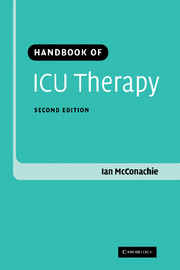Book contents
- Frontmatter
- Contents
- List of contributors
- Preface
- Part I Basic principles
- 1 Cardiac function, monitoring, oxygen transport
- 2 Shock
- 3 Oxygen therapy
- 4 Central venous access
- 5 Fluid therapy in ICU
- 6 Anaemia and blood transfusion
- 7 Nutrition
- 8 Non-invasive mechanical ventilation
- 9 Principles of IPPV
- 10 Modes of ventilation and ventilatory strategies
- 11 Weaning and tracheostomy
- 12 Vasoactive drugs
- 13 Infection and infection control
- 14 Sedation, analgesia and neuromuscular blockade
- 15 Continuous renal replacement therapy
- 16 Withholding and withdrawing therapy in the ICU
- Part II Specific problems
- Index
16 - Withholding and withdrawing therapy in the ICU
Published online by Cambridge University Press: 24 August 2009
- Frontmatter
- Contents
- List of contributors
- Preface
- Part I Basic principles
- 1 Cardiac function, monitoring, oxygen transport
- 2 Shock
- 3 Oxygen therapy
- 4 Central venous access
- 5 Fluid therapy in ICU
- 6 Anaemia and blood transfusion
- 7 Nutrition
- 8 Non-invasive mechanical ventilation
- 9 Principles of IPPV
- 10 Modes of ventilation and ventilatory strategies
- 11 Weaning and tracheostomy
- 12 Vasoactive drugs
- 13 Infection and infection control
- 14 Sedation, analgesia and neuromuscular blockade
- 15 Continuous renal replacement therapy
- 16 Withholding and withdrawing therapy in the ICU
- Part II Specific problems
- Index
Summary
“To cure sometimes, to relieve often, to comfort always”
15th Century French quoteMany patients die in intensive care unit (ICU) either as a result of failed therapy or, increasingly, as a result of withheld or withdrawn therapy. It wasn't always so; in the early days patients were only seen as appropriate for ICU admission if they were clearly recoverable. Now ICU is sometimes seen as a place where patients go to die.
Indeed, it is estimated that:
20% of all Americans over the age of 65 die in or having recently been in ICU (half of all the deaths in hospital),
10–12% of all health care expenditure in America is spent in the last 6 months of patients' lives.
Almost certainly these percentages will be less in Europe and the UK (so far) but, even in the UK, dying is almost an everyday occurrence in ICU.
Thus it is increasingly important to address:
end-of-life (EOL) care in the ICU,
withholding and withdrawing of therapy,
optimal care of the dying patient.
This chapter will discuss these three aspects of ICU therapy, although unlike other chapters, there may be as many questions raised as answered. Much is, and will probably remain, controversial.
- Type
- Chapter
- Information
- Handbook of ICU Therapy , pp. 197 - 222Publisher: Cambridge University PressPrint publication year: 2006



